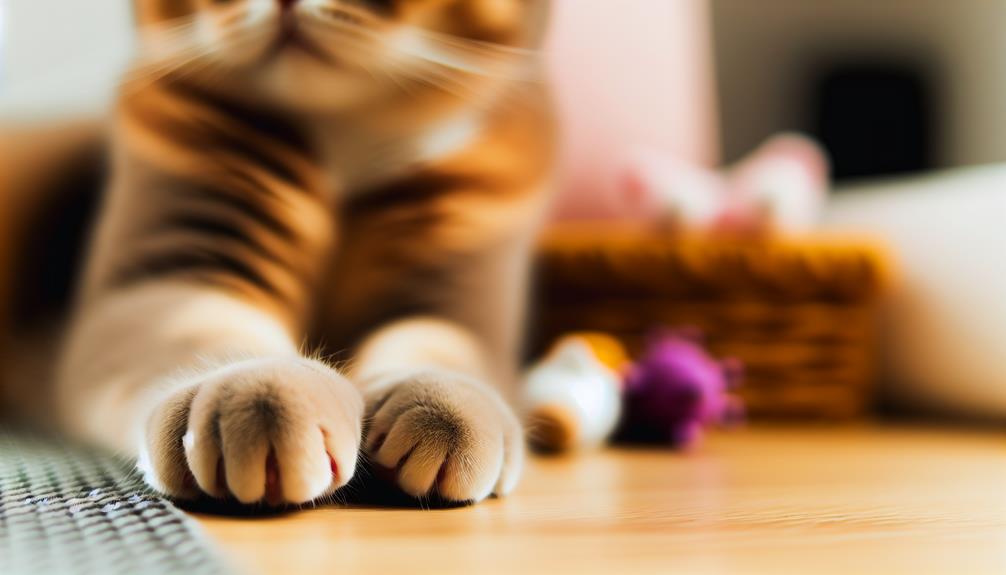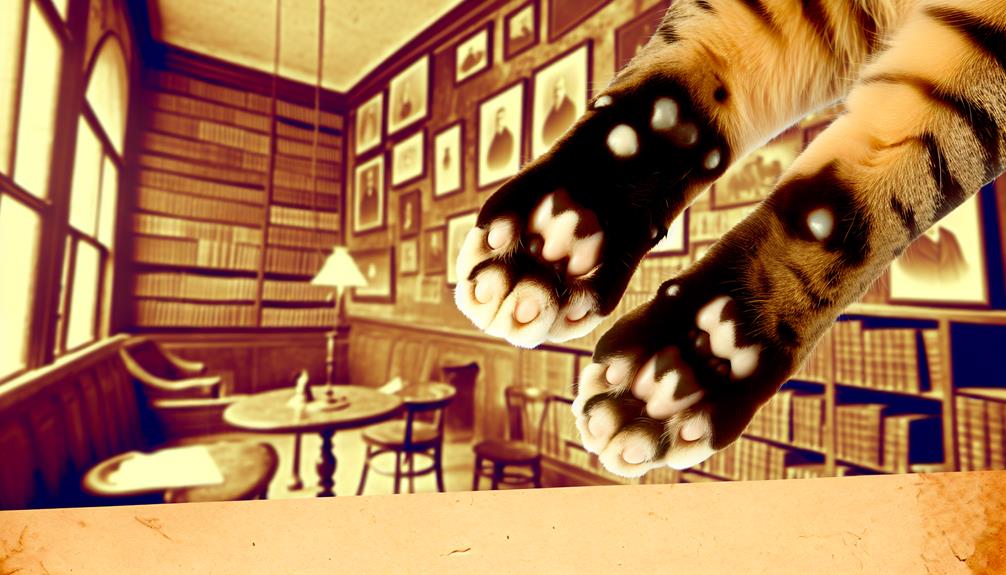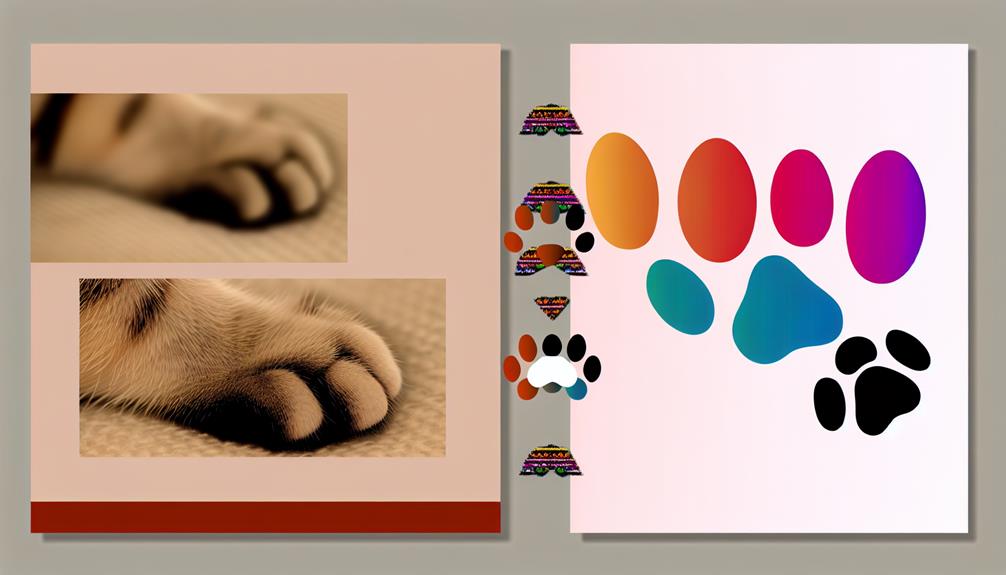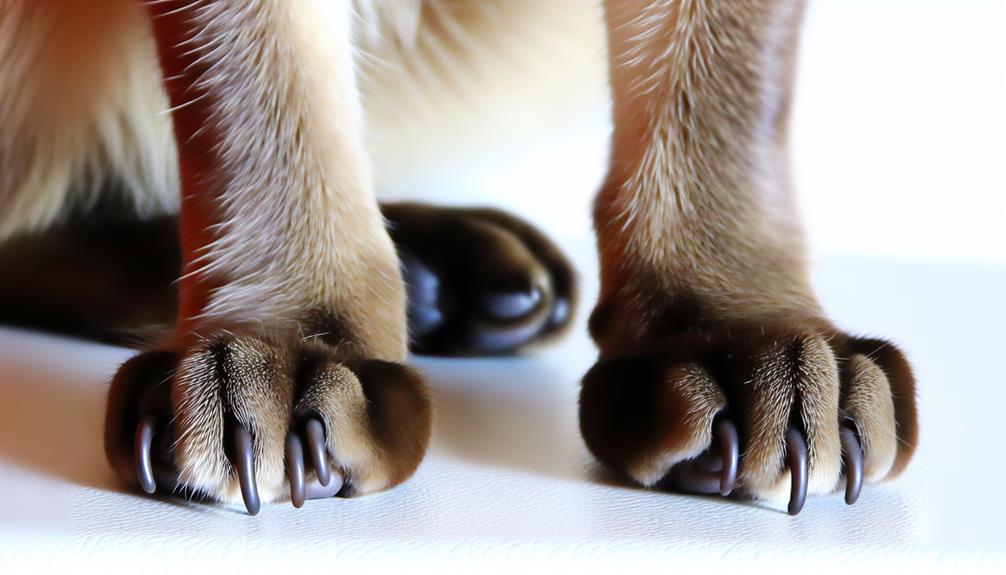When you look at a cat's paws, you're not just seeing a simple structure; you're observing a marvel of evolution and adaptability. You might think a cat has the same number of toes as other animals, but cats are unique in their own ways. Typically, they have 18 toes, but some cats break the mold with polydactyly. Curious about why some cats have extra toes and how it affects their abilities? There's a fascinating blend of genetics and practical advantages behind it all. Let's explore the intricacies of feline toes and their surprising variations.
Typical Cat Toe Count
Most domestic cats typically have a total of 18 toes, with five toes on each of their front paws and four toes on each of their back paws. Understanding the toes anatomy of a cat is essential for grasping their toe function and overall physiology.
Each toe consists of three bones, similar to the phalanges in human fingers. The bones are connected by joints, which are enveloped in a capsule containing synovial fluid to facilitate smooth movement. The outermost bone in each toe supports a claw, which is retractable. This retractability is a unique feature allowing cats to maintain their claws' sharpness by protecting them when not in use.
The front paws' extra toe, often referred to as the dewclaw, is located higher up on the leg and doesn't typically make contact with the ground. Despite this, it plays a critical role in providing additional grip and aiding in climbing or grasping prey. The back paws, with their four toes, are structured to provide stability and propulsion during movement.
The toes are equipped with an array of sensory receptors, contributing to a cat's keen sense of touch. These receptors, along with the pads on each toe, help a cat gauge the texture and temperature of surfaces, which is fundamental for predatory behavior. The pads also serve as shock absorbers, minimizing the impact on their joints during jumps and swift movements.
Front Paws Vs. Hind Paws
The anatomical distinctions between a cat's front paws and hind paws greatly influence their functionality and role in a cat's movement and behavior. You'll notice that a cat's front paws typically possess five toes each, while the hind paws usually have four. This difference in paw structure reflects their specialized roles. The additional toe on the front paws, often referred to as the dewclaw, is positioned higher up and doesn't make contact with the ground under normal walking conditions.
Front paws are more versatile and dexterous, allowing your cat to grasp objects, climb, and interact with their environment. The toe function here is essential for behaviors like hunting and playing. Each of the five toes on the front paws is equipped with a retractable claw, aiding in both predation and self-defense. This configuration is particularly beneficial for climbing, as the extra toe increases grip and stability.
On the other hand, hind paws are primarily built for propulsion and balance. With only four toes, they have fewer claws to manage, which simplifies their role in providing powerful jumps and swift sprints. The paw structure here is optimized for strength and endurance. The hind paws bear more weight and act as the main drivers during running or pouncing, giving your cat the ability to leap impressive distances.
Understanding these differences in paw structure and toe function enhances your appreciation of a cat's remarkable agility and adaptability. Each paw type has evolved to support distinct aspects of a cat's predatory and playful behaviors, making them the versatile creatures they are.
Polydactyl Cats Explained

Polydactyl cats, often referred to as "mitten cats" due to their unique paw structure, exhibit a fascinating genetic anomaly where they possess more than the usual number of toes. Typically, a cat has five toes on each front paw and four on each hind paw. However, polydactyl cats can have six or even more toes on their paws. This condition, known as polydactyly, results from a genetic mutation that affects the expression of limb development genes.
Understanding polydactyl traits requires examining their anatomical and functional aspects. Polydactyl cats often have larger paws, which can give the appearance of "thumbs" or extra digits. These additional toes are usually fully functional, equipped with normal bone, muscle, and claw structures. Regarding locomotion and dexterity, polydactyl cats often exhibit enhanced climbing and hunting abilities. The extra toes may provide additional grip and stability, making these cats particularly adept in their movements.
The historical significance of polydactyl cats is notable. Sailors in the 18th and 19th centuries favored these cats, believing that their extra toes provided better balance on ships and increased their hunting prowess, which was essential for controlling rodent populations onboard. As a result, polydactyl cats became popular mascots on many seafaring vessels, contributing to their spread across various ports and coastal regions.
Genetic Factors
Exploring the anatomical uniqueness of polydactyl cats naturally leads to questions about the genetic underpinnings of this intriguing trait. Fundamentally, the occurrence of polydactyly in cats is attributed to genetic mutations that affect toe development. The primary gene involved is known as the Sonic Hedgehog (SHH) gene, which plays a critical role in embryonic development. Mutations in this gene can lead to an altered expression pattern, resulting in the formation of additional toes.
When examining the inheritance patterns, you'll find that polydactyly is generally an autosomal dominant trait. This means that a single copy of the mutated gene from either parent can result in a polydactyl offspring. If one parent is polydactyl, there's about a 50% chance their kittens will also exhibit the trait. This makes it relatively straightforward to track and predict within breeding populations.
Furthermore, these genetic mutations don't just randomly occur; they often cluster in specific regions. For instance, polydactyl cats are more commonly found in certain geographical areas, like the northeastern United States, due to the historical breeding practices and the limited gene pool of early settlers' cats. Understanding these mutations at a molecular level provides insight into how genetic diversity and environmental factors influence toe development in felines.
In addition to the SHH gene, other genetic factors and modifiers may contribute to the expression and variation in the number of toes. Research continues to explore these intricate genetic pathways to better comprehend the full spectrum of polydactyly. By delving into these genetic intricacies, you can appreciate the complex biological tapestry that results in the charming phenomenon of extra-toed cats.
Famous Polydactyl Cats

You've likely heard of Ernest Hemingway's fondness for polydactyl cats, a trait that has made his Key West home famous for its six-toed feline residents. Additionally, the Guinness World Record holder for the cat with the most toes has an astounding 28 digits. These instances underscore the fascinating genetic variations in polydactyl cats, highlighting both historical and contemporary examples.
Hemingway's Beloved Felines
Hemingway's Beloved Felines
Ernest Hemingway's affection for cats, particularly those with polydactyl traits, is a well-documented aspect of his life. These unique cats, often having six or more toes on each paw, were not just pets but part of Hemingway's legacy. At his home in Key West, Florida, you'll find descendants of his original polydactyl cats, continuing to inspire visitors and literary enthusiasts alike.
Hemingway's connection with these felines was profound. He received his first polydactyl cat from a ship captain, and this bond grew into a lifelong passion. Polydactyl cats are sometimes called "Hemingway cats" in his honor. They are believed to have brought him comfort and perhaps even literary inspiration in his prolific writing career.
Here's a quick overview of Hemingway's polydactyl cats:
| Cat Name | Number of Toes | Notable Trait |
|---|---|---|
| Snow White | 6 per paw | First polydactyl cat |
| Princess | 7 per paw | Known for agility |
| Captain | 6 per paw | Given by a ship captain |
| Duke | 7 per paw | Highly affectionate |
These beloved cats remain a symbol of Hemingway's unique connection with his pets, enriching both his personal life and literary works.
Guinness World Record Holder
Holding the Guinness World Record for the most toes on a cat, Jake, a ginger tabby from Canada, has captured the fascination of feline enthusiasts worldwide. Jake boasts an impressive 28 toes, a condition known as polydactylism. Each of his paws features seven toes, considerably more than the typical eighteen toes found in the average cat. This extraordinary trait has made Jake one of the most well-known record breaking felines.
Polydactyl cats, like Jake, exhibit unique toe variations due to a genetic mutation. These additional toes can appear on both the front and hind paws, although they are more commonly found on the forepaws. Jake's condition is a striking example of how genetic diversity can result in remarkable physical traits.
In the world of polydactyl cats, having more toes can sometimes provide advantages, such as enhanced climbing and hunting abilities. However, it's crucial to monitor the health of these extra digits, as they can occasionally lead to complications. Jake's record-breaking status not only highlights his unique toe variations but also brings attention to the fascinating genetic intricacies found within the feline population.
Toe Health and Care
Proper toe health and care are essential for maintaining your cat's overall well-being. Ensuring your cat's toes remain in peak condition involves a few critical practices, such as maintaining toe hygiene and regular nail trimming. Keeping your cat's toes clean is important to prevent infections and other health issues. Dirt, litter, and other debris can accumulate between their toes, leading to potential bacterial growth and discomfort. Regularly inspect your cat's toes and gently clean them with a damp cloth if necessary, ensuring you don't use any harmful chemicals.
Nail trimming is another important aspect of toe health. Overgrown nails can cause significant discomfort and may even lead to infections or injuries. To trim your cat's nails, you'll need a pair of specialized cat nail clippers. Hold your cat gently but firmly, and extend each toe by pressing on the top and bottom of the paw. Trim only the sharp tip of each nail, avoiding the quick—a sensitive area containing blood vessels and nerves. Cutting too close to the quick can cause pain and bleeding.
In addition to these routine practices, regularly check for signs of health issues, such as swelling, redness, or unusual discharge around the toes. These could indicate infections, ingrown nails, or other medical conditions requiring veterinary attention. It's also advisable to provide your cat with scratching posts to help them naturally wear down their nails and maintain healthy toes.
Fun Facts About Cat Toes

Maintaining your cat's toe health is fundamental, but there's more to these fascinating appendages than just hygiene and care. Cat toes are remarkable in their structure and functionality, playing significant roles in various aspects of a cat's life. One of the unique toe functions includes their use in silent, stealthy movements. Cats are digitigrade animals, meaning they walk on their toes. This toe-walking gait allows for enhanced agility and quiet stalking, essential for both hunting and evading predators.
Another intriguing aspect is cat claw mechanics. Unlike other animals, a cat's claws are retractable, which means they can be extended and retracted at will. This retraction mechanism helps keep the claws sharp and ready for action, whether that's for climbing, catching prey, or self-defense. The ability to retract claws also prevents wear and tear, ensuring that they remain effective tools throughout the cat's life.
Furthermore, a cat's toes are equipped with sensitive pads that provide crucial sensory feedback. These pads help in detecting textures, temperatures, and vibrations, aiding in navigation and interaction with their environment. The toe pads also play a significant role in the cat's balance and stability, contributing to their exceptional climbing and jumping abilities.
Additionally, some cats possess a genetic trait known as polydactylism, where they have extra toes. This condition doesn't generally affect their health but can enhance their grasping and climbing capabilities. Famous for their "thumb-like" extra toes, polydactyl cats were prized by sailors for their superior hunting skills and balance on ships.
Conclusion
In summary, understanding your cat's toes is essential for their health and well-being. Did you know that about 40% of polydactyl cats are found in the northeastern United States? This fascinating genetic mutation not only enhances their grip and stability but also adds a unique charm. Regular toe checks and proper claw care guarantee your feline friend's paws remain in top condition. By staying informed, you're better equipped to provide the best care for your cat's extraordinary feet.
